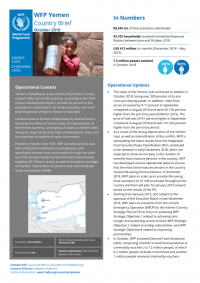WFP Yemen Country Brief, October 2018
In Numbers
99,345 mt of food assistance distributed
93,192 households received Immediate Response Rations between June and October 2018
US$ 412 million six months (December 2018 – May 2019)
7.2 million people assisted in October 2018
Operational Context
Yemen is classified as a low-income, food-deficit country, ranked 178th out of 189 countries, according to the 2018 Human Development Report. At least 50 percent of the population is estimated to be living in poverty, and more than 90 percent of food in Yemen is imported.
Limited access to food is compounded by several factors, including the effects of low incomes, the depreciation of the Yemeni currency, uncertainty of access to Yemen’s Red Sea ports, large family sizes, high unemployment rates, and non-payment of salaries of most civil servants.
Present in Yemen since 1967, WFP currently aims to save lives and protect livelihoods in emergencies, and specifically increase food consumption through the scaleup of life-saving emergency food assistance (particularly targeting IPC Phase 4 areas), as well as to expand coverage of nutrition interventions to prevent and treat moderate acute malnutrition (MAM).
Operational Updates
• The value of the Yemeni riyal continued to weaken in October 2018, losing over 200 percent of its precrisis purchasing power. In addition, retail food prices increased by 9-17 percent in September compared to August 2018 and were 65-136 percent higher than the pre-crisis period (March 2015). The price of fuel was 24-41 percent higher in September compared to August 2018 and was 101-232 percent higher than the pre-crisis period.
• As a result of the strong depreciation of the Yemeni riyal, as well as intensification of the conflict, WFP is anticipating the latest results from the Integrated Food Security Phase Classification (IPC), scheduled to be released in early December 2018, which are expected to show an increase in the number of severely food insecure persons in the country. WFP has developed various operational plans to ensure that the most food-insecure persons in the country receive life-saving food assistance. In December 2018, WFP plans to scale up to provide life-saving food assistance to 10 million people throughout the country and then will plan for January 2019 onward based on the results of the IPC.
• Starting from January 2019, and subject to the approval of the Executive Board in late November 2018, WFP plans to transition from the current Emergency Operation (EMOP) to the Interim Country Strategic Plan (ICSP) to focus on achieving WFP Strategic Objective 1 related to achieving zero hunger and protecting access to food, WFP Strategic Objective 2 related to ending malnutrition, and WFP Strategic Objective 8 related to improving partnerships.
• In October, WFP provided General Food Assistance (GFA), comprising of either in-kind food assistance or commodity vouchers, to 7.2 million people, of which 6.2 million people received in-kind food and another 1 million people received commodity vouchers.
https://reliefweb.int/report/yemen/wfp-yemen-country-brief-october-2018


